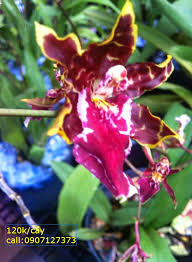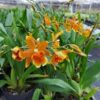# Techniques for Caring for Oncidium Orchids in Greenhouses

Oncidium orchids, often referred to as “Dancing Lady Orchids,” are known for their vibrant, intricate flowers that can brighten any greenhouse environment. Successfully cultivating these stunning plants requires understanding their specific needs and implementing effective care techniques. This comprehensive guide will explore various aspects of caring for Oncidium orchids in greenhouses, ensuring they thrive and produce beautiful blooms.
## 1. Understanding Oncidium Orchids
### 1.1 Characteristics of Oncidium Orchids
Oncidium orchids belong to the family Orchidaceae and are known for their diverse range of colors, sizes, and shapes. The flowers often feature unique markings and can appear in clusters, creating a spectacular display.
– **Common Colors**: These orchids typically showcase shades of yellow, brown, white, and orange, often with intricate patterns and spots.
– **Growth Habit**: Oncidium orchids can grow as epiphytes, lithophytes, or terrestrial plants, which influences their care requirements.
### 1.2 Ideal Growing Conditions
Before diving into specific care techniques, it’s essential to understand the ideal growing conditions for Oncidium orchids in a greenhouse setting:
– **Temperature**: Oncidium orchids thrive in temperatures between 65°F and 85°F (18°C to 29°C) during the day and slightly cooler at night. Maintaining a consistent temperature range is crucial for healthy growth.
– **Humidity**: High humidity levels (50-70%) are ideal for these orchids, as they naturally grow in humid environments. A greenhouse environment can facilitate this if equipped with proper humidity controls.
– **Light**: Oncidium orchids prefer bright, indirect light. Too much direct sunlight can scorch the leaves, while insufficient light can hinder flowering.
## 2. Setting Up the Greenhouse Environment
### 2.1 Choosing the Right Greenhouse
When caring for Oncidium orchids, selecting the appropriate greenhouse is essential. Here are some factors to consider:
– **Size**: Ensure your greenhouse has enough space for air circulation and light penetration. A larger greenhouse allows for better airflow, reducing the risk of fungal infections.
– **Material**: Greenhouses can be made from various materials, including glass, plastic, and polycarbonate. Each material offers different levels of insulation and light transmission. Choose one that suits your climate and budget.
### 2.2 Ventilation
Good ventilation is crucial in maintaining a healthy greenhouse environment for Oncidium orchids:
– **Natural Ventilation**: Incorporate vents or windows that can be opened to allow fresh air circulation. This helps regulate temperature and humidity levels.
– **Mechanical Ventilation**: In hotter climates, consider installing fans to enhance airflow and prevent overheating. This is particularly important during summer months.
### 2.3 Temperature Control
Maintaining optimal temperatures is vital for the health of your orchids:
– **Heating Systems**: In colder climates, invest in heating systems to maintain consistent temperatures during the winter months. Choose heaters that provide even heating without creating hot spots.
– **Cooling Systems**: In hot climates, evaporative coolers or fans can help lower temperatures during the day. Shade cloths can also be used to reduce heat buildup.
## 3. Potting and Growing Medium
### 3.1 Choosing the Right Pot
The choice of pot is crucial for the health of Oncidium orchids:
– **Pot Type**: Use pots made from breathable materials like clay or plastic with drainage holes to prevent waterlogging. Clear plastic pots allow you to monitor root health.
– **Size**: Choose a pot that is slightly larger than the current root mass, allowing room for growth without excessive space that can hold too much moisture.
### 3.2 Selecting the Growing Medium
Oncidium orchids require a well-draining growing medium:
– **Mix Components**: A typical mix for Oncidium orchids includes a combination of bark, perlite, and sphagnum moss. This mix ensures good drainage and aeration while retaining some moisture.
– **Repotting**: Repot every 1-2 years or when the medium breaks down. This helps prevent root rot and ensures that the plants have fresh nutrients.
## 4. Watering Techniques
### 4.1 Understanding Watering Needs
Watering is one of the most critical aspects of orchid care:
– **Frequency**: Water Oncidium orchids when the top inch of the growing medium feels dry. This could mean watering every 5-7 days, depending on the climate and humidity levels.
– **Water Quality**: Use distilled or rainwater whenever possible, as tap water may contain minerals and chemicals that can harm the orchids.
### 4.2 Watering Methods
Implement effective watering techniques to ensure your Oncidium orchids receive adequate moisture:
– **Soaking Method**: For thorough watering, place the pot in a basin of water for about 15-30 minutes, allowing the medium to absorb moisture from the bottom.
– **Spray Method**: Use a spray bottle to mist the leaves and roots, increasing humidity around the plant. Avoid letting water sit in the crown of the plant to prevent rot.
## 5. Fertilization Techniques
### 5.1 Understanding Fertilization Needs
Fertilization plays a crucial role in promoting healthy growth and vibrant blooms:
– **Frequency**: Fertilize Oncidium orchids every 2-4 weeks during the growing season (spring and summer) and reduce during dormancy (fall and winter).
– **Type of Fertilizer**: Use a balanced orchid fertilizer with a ratio of 30-10-10 or 20-20-20, diluted to half strength. This provides essential nutrients without overwhelming the plants.
### 5.2 Application Techniques
Implement effective fertilization techniques for optimal results:
– **Watering Before Fertilizing**: Water your orchids before applying fertilizer to prevent root burn.
– **Foliar Feeding**: Occasionally, use a liquid fertilizer for foliar feeding. Spray the leaves lightly to provide an additional nutrient source.
## 6. Light Management
### 6.1 Providing Adequate Light
Proper light management is essential for healthy Oncidium orchids:
– **Light Requirements**: Provide bright, indirect light for 10-12 hours a day. Use grow lights if natural light is insufficient.
– **Monitoring Light Levels**: Keep an eye on the leaves. If they turn yellow, the orchids may be getting too much light. Dark green leaves indicate insufficient light.
### 6.2 Using Light Diffusers
To manage light exposure in a greenhouse:
– **Shade Cloths**: Use shade cloths during peak sunlight hours to prevent leaf burn while still allowing adequate light penetration.
– **Reflective Surfaces**: Incorporate reflective surfaces to maximize light distribution in the greenhouse.
## 7. Humidity Control
### 7.1 Understanding Humidity Needs
High humidity is crucial for the well-being of Oncidium orchids:
– **Ideal Humidity Levels**: Maintain humidity levels between 50% and 70% for optimal growth.
– **Signs of Low Humidity**: Wilting leaves and brown leaf tips indicate low humidity levels.
### 7.2 Humidity-Boosting Techniques
Implement various techniques to maintain adequate humidity:
– **Misting**: Regularly mist the orchids and the surrounding area to increase humidity.
– **Humidity Trays**: Place shallow trays filled with water and pebbles under the pots to create a humid microclimate.
## 8. Pest and Disease Management
### 8.1 Identifying Common Pests
Monitoring for pests is crucial for the health of your orchids:
– **Common Pests**: Look out for aphids, mealybugs, scale insects, and spider mites. Regularly inspect the leaves and stems for signs of infestation.
– **Signs of Infestation**: Sticky residue, webbing, or discolored leaves can indicate a pest problem.
### 8.2 Managing Pests and Diseases
Implement effective pest control measures:
– **Natural Remedies**: Use insecticidal soap or neem oil to treat infestations. These methods are less harmful to beneficial insects and the environment.
– **Regular Maintenance**: Keep the greenhouse clean and free from debris to reduce pest habitats. Regularly remove dead leaves and spent flowers.
### 8.3 Disease Prevention
Preventing diseases is key to maintaining healthy orchids:
– **Air Circulation**: Ensure good airflow around your orchids to reduce the risk of fungal diseases.
– **Avoid Overwatering**: Proper watering practices help prevent root rot and other moisture-related issues.
## 9. Seasonal Care
### 9.1 Adjusting Care for Seasonal Changes
Caring for Oncidium orchids requires seasonal adjustments:
– **Spring and Summer**: During the growing season, increase watering and fertilization to support new growth. Monitor light and humidity levels closely.
– **Fall and Winter**: Reduce watering and fertilization as the plants enter dormancy. Keep temperatures stable and continue to provide adequate light.
### 9.2 Preparing for Flowering
To promote flowering, consider the following:
– **Temperature Fluctuations**: Some Oncidium orchids require a drop in temperature at night to trigger blooming. Aim for a temperature difference of 10-15°F (5-8°C).
– **Light Adjustment**: Gradually increase light exposure as the plants prepare to bloom, ensuring they receive sufficient light to encourage flower development.
## 10. Propagation Techniques
### 10.1 Understanding Propagation Methods
If you’re interested in propagating your Oncidium orchids, several methods can be used:
– **Division**: The most common method is dividing mature plants during repotting. Ensure each division has roots and at least one pseudobulb.
– **Keiki Production**: Some Oncidium orchids produce keikis (baby plants) on flower spikes. These can be carefully removed and potted
separately.
### 10.2 Successful Propagation Techniques
Implement effective techniques for successful propagation:
– **Timing**: Propagate during the spring when the plants are actively growing.
– **Post-Propagation Care**: Provide adequate light, humidity, and watering to help the new plants establish themselves.
## Conclusion
Caring for Oncidium orchids in a greenhouse requires attention to detail and a willingness to adapt to their specific needs. By understanding their growth habits, providing optimal environmental conditions, and implementing effective care techniques, you can cultivate healthy and beautiful orchids that will thrive and bloom for years to come. Embrace the challenge, and let the beauty of Oncidium orchids transform your greenhouse into a vibrant oasis. Happy growing!

